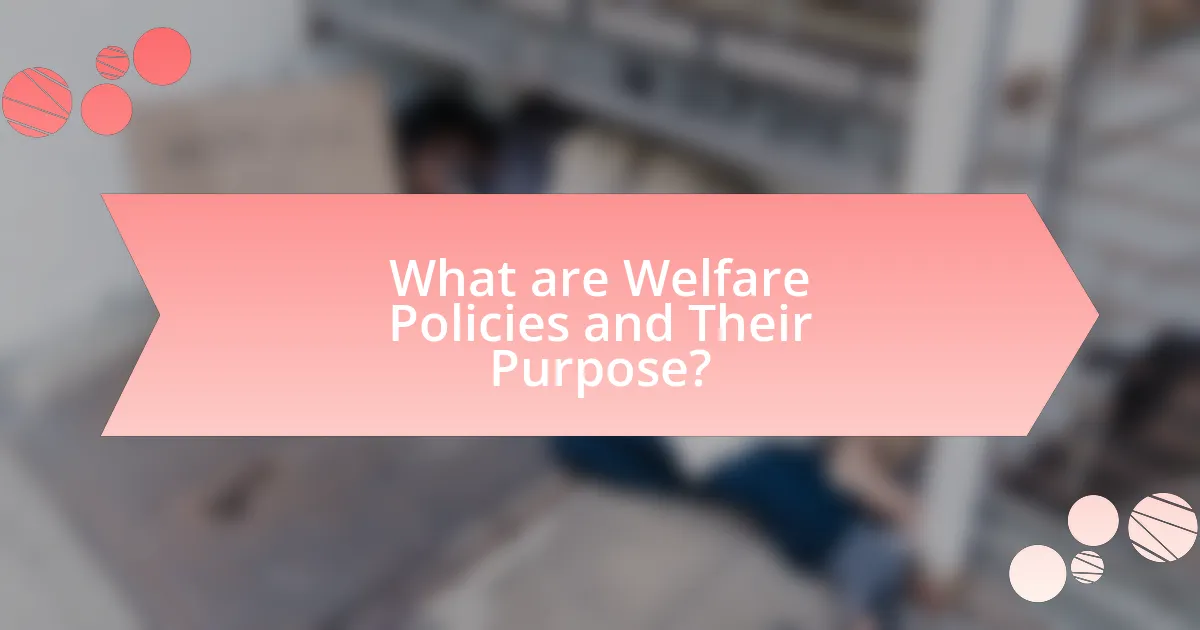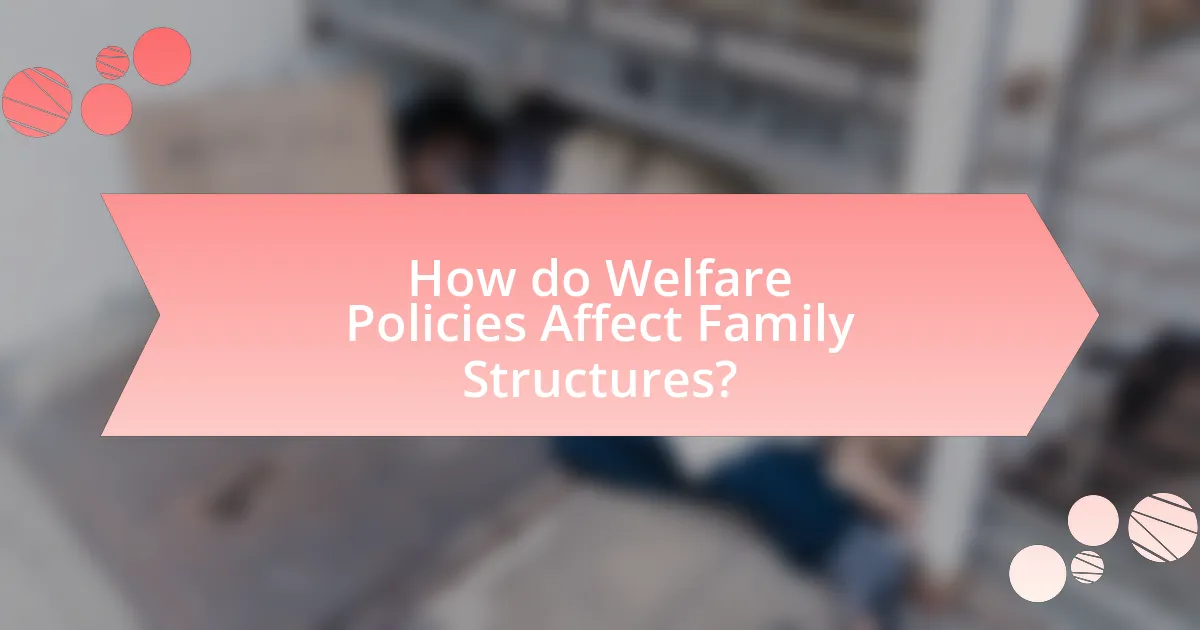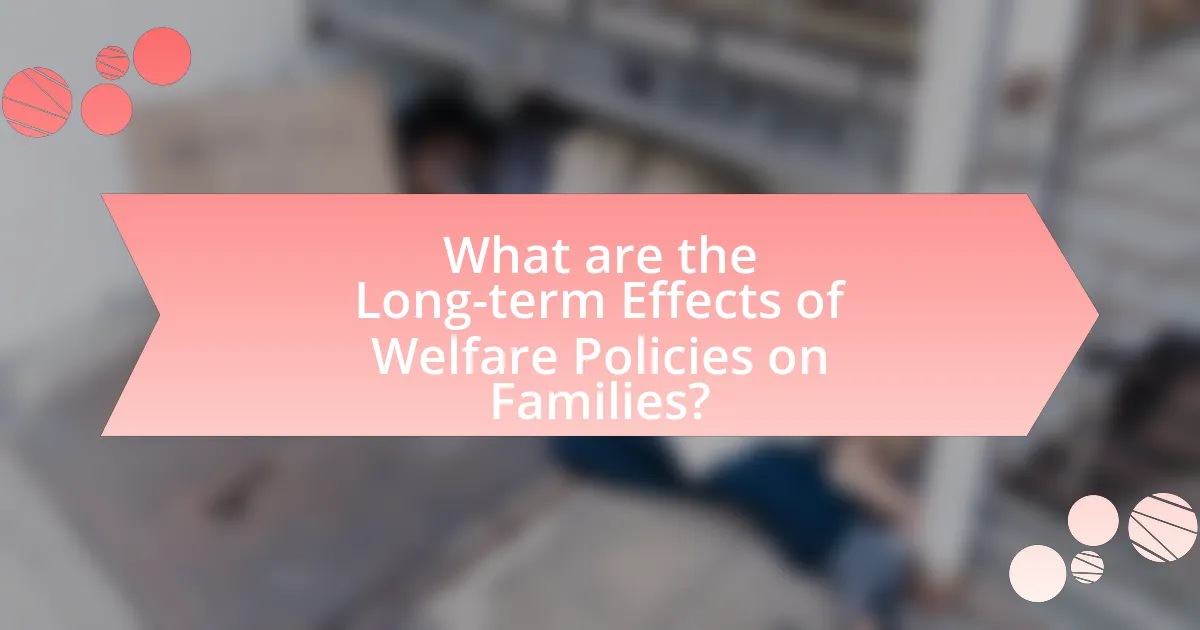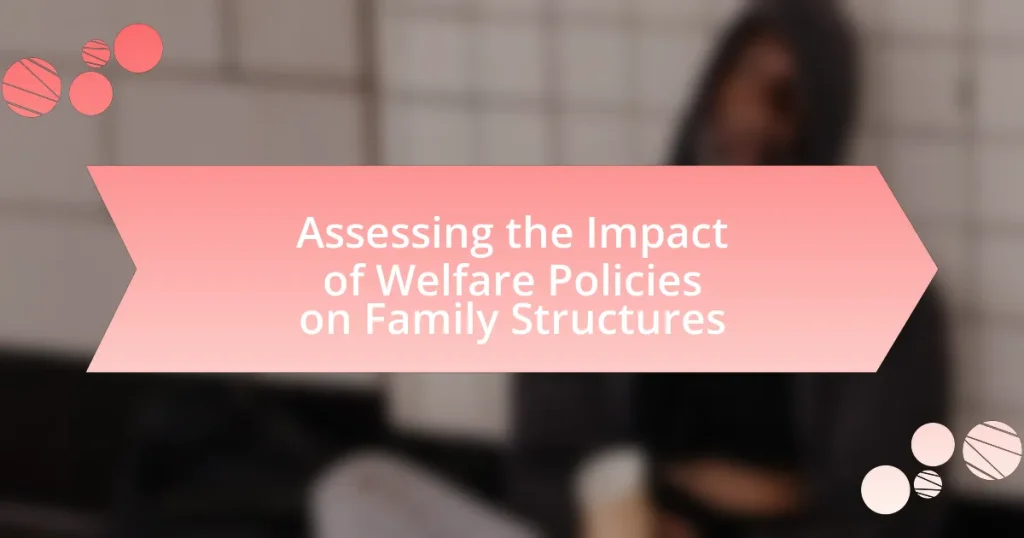Welfare policies are government programs aimed at providing financial assistance and support services to individuals and families in need, primarily to alleviate poverty and promote social welfare. This article assesses the impact of these policies on family structures, exploring how they support families through financial aid, healthcare access, and social services. It examines the common types of welfare policies, their variations across regions, and their effects on family dynamics, stability, and educational outcomes for children. Additionally, the article discusses the long-term implications of welfare policies on intergenerational family structures and social mobility, highlighting both the positive and negative consequences of reliance on government assistance.

What are Welfare Policies and Their Purpose?
Welfare policies are government programs designed to provide financial assistance and support services to individuals and families in need. Their primary purpose is to alleviate poverty, reduce inequality, and promote social welfare by ensuring access to basic needs such as food, housing, healthcare, and education. For example, in the United States, programs like Temporary Assistance for Needy Families (TANF) and Supplemental Nutrition Assistance Program (SNAP) aim to support low-income families, demonstrating the effectiveness of welfare policies in addressing economic disparities and improving family stability.
How do welfare policies aim to support families?
Welfare policies aim to support families by providing financial assistance, access to healthcare, and social services that enhance family stability and well-being. These policies, such as Temporary Assistance for Needy Families (TANF) and the Supplemental Nutrition Assistance Program (SNAP), offer direct monetary support to low-income families, helping them meet basic needs like food and housing. Research indicates that families receiving welfare benefits experience reduced poverty rates and improved health outcomes, as evidenced by a 2019 study from the Urban Institute, which found that TANF significantly decreases food insecurity among participating households.
What types of welfare policies are most common?
The most common types of welfare policies include social assistance programs, unemployment benefits, food assistance programs, and healthcare subsidies. Social assistance programs, such as Temporary Assistance for Needy Families (TANF) in the United States, provide financial aid to low-income families. Unemployment benefits offer temporary financial support to individuals who have lost their jobs, with programs varying by state. Food assistance programs, like the Supplemental Nutrition Assistance Program (SNAP), help families afford nutritious food. Healthcare subsidies, often provided under programs like Medicaid, assist low-income individuals in accessing medical care. These policies are designed to alleviate poverty and support family stability, reflecting their prevalence in welfare systems globally.
How do these policies vary by region or country?
Welfare policies vary significantly by region and country, influenced by economic conditions, cultural values, and political ideologies. For instance, Scandinavian countries like Sweden and Norway implement comprehensive welfare systems that provide extensive support for families, including parental leave and child care benefits, resulting in higher family stability and lower child poverty rates. In contrast, the United States has a more fragmented welfare system, with limited support for families, leading to higher rates of child poverty and single-parent households. Research by the Organisation for Economic Co-operation and Development (OECD) highlights that countries with robust welfare policies tend to have stronger family structures, as evidenced by lower divorce rates and better child outcomes.
Why is it important to assess the impact of welfare policies?
Assessing the impact of welfare policies is crucial because it determines their effectiveness in improving the well-being of families and individuals. Evaluating these policies allows policymakers to identify strengths and weaknesses, ensuring that resources are allocated efficiently to address poverty, health, and education. For instance, studies have shown that welfare programs can significantly reduce child poverty rates; the U.S. Census Bureau reported that in 2020, government assistance lifted approximately 3 million children out of poverty. This evidence underscores the necessity of continuous assessment to adapt and enhance welfare policies for better outcomes.
What are the potential positive effects on family structures?
Potential positive effects on family structures include increased financial stability, improved access to healthcare, and enhanced educational opportunities. Welfare policies can provide families with essential resources, reducing economic stress and allowing for better parenting practices. For instance, studies have shown that families receiving welfare support experience lower rates of poverty, which correlates with improved child development outcomes. Additionally, access to healthcare through welfare programs can lead to better physical and mental health for family members, fostering a more supportive home environment. Educational assistance provided by welfare initiatives can also empower families, leading to higher educational attainment and better job prospects for future generations.
What negative consequences might arise from these policies?
Negative consequences that might arise from welfare policies include increased dependency on government assistance, which can undermine personal initiative and self-sufficiency. Research indicates that prolonged reliance on welfare can lead to a cycle of poverty, as families may become accustomed to receiving aid rather than seeking employment or education opportunities. Additionally, welfare policies can inadvertently create disincentives for marriage, as benefits may decrease with combined incomes, leading to higher rates of single-parent households. Studies show that children in single-parent families often face greater economic hardships and social challenges, which can perpetuate the cycle of poverty.

How do Welfare Policies Affect Family Structures?
Welfare policies significantly influence family structures by providing financial support that can alter household dynamics. For instance, policies such as Temporary Assistance for Needy Families (TANF) can lead to increased single-parent households, as financial aid may incentivize single motherhood. Research indicates that welfare benefits can reduce poverty levels, which in turn affects family stability and cohesion. A study by the National Bureau of Economic Research found that states with more generous welfare programs experienced a decrease in child poverty rates, suggesting that financial support can lead to more stable family environments. Additionally, welfare policies can impact marriage rates, as economic security often plays a crucial role in decisions about marriage and family formation.
What changes in family dynamics can result from welfare policies?
Welfare policies can lead to significant changes in family dynamics, primarily by altering economic stability and caregiving roles. For instance, increased financial support can reduce stress within families, allowing for improved relationships and better parenting practices. Research indicates that families receiving welfare benefits often experience enhanced emotional well-being, which can foster stronger family bonds. Additionally, welfare policies may shift traditional gender roles, as financial assistance allows both parents to engage more equally in caregiving and household responsibilities. Studies, such as those conducted by the Urban Institute, show that these changes can lead to more equitable partnerships and improved child outcomes, demonstrating the profound impact of welfare policies on family structures.
How do these policies influence family size and composition?
Welfare policies significantly influence family size and composition by providing financial support and resources that affect reproductive choices and family dynamics. For instance, policies such as child tax credits and subsidized childcare can encourage families to have more children by alleviating the financial burden associated with raising children. Research indicates that countries with generous parental leave and childcare support tend to have higher fertility rates, as seen in Scandinavian nations where such policies are linked to increased family size. Additionally, welfare policies can impact family composition by promoting single-parent households through support systems that assist single mothers, thereby altering traditional family structures.
What role do welfare policies play in family stability?
Welfare policies significantly contribute to family stability by providing financial support and resources that alleviate economic stress. These policies, such as unemployment benefits, food assistance, and childcare subsidies, help families meet basic needs, reducing the likelihood of poverty-related issues that can destabilize family structures. Research indicates that families receiving welfare support experience lower rates of domestic conflict and improved mental health outcomes, which are crucial for maintaining stable relationships. For instance, a study by the Urban Institute found that families with access to welfare programs reported higher levels of family cohesion and lower incidences of separation or divorce, demonstrating the positive impact of these policies on family stability.
How do welfare policies impact economic conditions for families?
Welfare policies significantly improve economic conditions for families by providing financial assistance, access to healthcare, and support services. These policies, such as Temporary Assistance for Needy Families (TANF) and Supplemental Nutrition Assistance Program (SNAP), directly alleviate poverty and reduce food insecurity. For instance, research from the Center on Budget and Policy Priorities indicates that SNAP lifted approximately 3.6 million people out of poverty in 2019, demonstrating the tangible benefits of such programs. Additionally, welfare policies can enhance family stability by reducing stress associated with financial hardship, which in turn fosters better educational outcomes for children and overall family well-being.
What financial benefits do families receive from welfare policies?
Families receive various financial benefits from welfare policies, including direct cash assistance, food assistance, housing subsidies, and healthcare coverage. Direct cash assistance programs, such as Temporary Assistance for Needy Families (TANF), provide families with monthly payments to help cover basic living expenses. Food assistance programs like the Supplemental Nutrition Assistance Program (SNAP) offer families funds to purchase food, significantly alleviating food insecurity. Housing subsidies, such as those provided through the Housing Choice Voucher Program, help families afford stable housing by reducing their rent burden. Additionally, welfare policies often include access to healthcare through programs like Medicaid, which ensures that families can receive necessary medical services without incurring prohibitive costs. These benefits collectively support family stability and improve overall well-being, as evidenced by studies showing that welfare assistance reduces poverty rates and enhances children’s health and educational outcomes.
How do these financial benefits affect children’s well-being?
Financial benefits significantly enhance children’s well-being by providing essential resources for their development and stability. These benefits enable families to afford necessities such as nutritious food, healthcare, and educational opportunities, which are crucial for children’s physical and cognitive growth. Research indicates that children from families receiving financial assistance exhibit improved academic performance and better health outcomes compared to those from low-income families without such support. For instance, a study published in the Journal of Policy Analysis and Management found that increased financial support correlates with higher school attendance rates and lower instances of childhood obesity, demonstrating the direct impact of financial benefits on children’s overall well-being.

What are the Long-term Effects of Welfare Policies on Families?
Long-term welfare policies can lead to both positive and negative effects on families. On the positive side, these policies often provide financial stability, which can improve children’s educational outcomes and overall well-being. For instance, studies indicate that families receiving welfare support are more likely to invest in their children’s education, leading to higher graduation rates. Conversely, negative effects may include dependency on government assistance, which can hinder self-sufficiency and reduce motivation to seek employment. Research from the National Bureau of Economic Research shows that prolonged reliance on welfare can create cycles of poverty that affect multiple generations within families. Thus, while welfare policies can offer immediate relief, their long-term implications on family dynamics and economic mobility are complex and multifaceted.
How do welfare policies influence intergenerational family structures?
Welfare policies significantly influence intergenerational family structures by providing financial support that can alter living arrangements and caregiving dynamics. For instance, policies such as child allowances and housing assistance enable families to maintain multi-generational households, where grandparents, parents, and children live together. Research indicates that in countries with robust welfare systems, like Sweden, approximately 20% of children live in multi-generational homes, compared to only 10% in the U.S., highlighting the impact of welfare on family configurations. Additionally, welfare programs can relieve economic pressures, allowing older generations to take on caregiving roles without the burden of financial instability, thus reinforcing family ties across generations.
What patterns emerge in families that rely on welfare over time?
Families that rely on welfare over time often exhibit patterns of economic instability, increased reliance on government assistance, and challenges in achieving upward mobility. Research indicates that prolonged dependence on welfare can lead to a cycle of poverty, where families experience difficulties in transitioning to self-sufficiency due to barriers such as limited access to education and job opportunities. For instance, a study by the Urban Institute found that families receiving welfare benefits often face significant obstacles, including inadequate job training and childcare support, which hinder their ability to improve their economic situation. Additionally, these families may experience higher rates of single-parent households, which can further complicate their financial stability and access to resources.
How do welfare policies affect educational outcomes for children?
Welfare policies significantly influence educational outcomes for children by providing financial support that enhances access to resources essential for learning. For instance, programs like the Supplemental Nutrition Assistance Program (SNAP) and Temporary Assistance for Needy Families (TANF) alleviate poverty-related stressors, allowing families to invest more in education-related expenses such as school supplies and extracurricular activities. Research indicates that children from families receiving welfare benefits tend to perform better academically; a study published in the Journal of Policy Analysis and Management found that children in households benefiting from welfare programs had higher test scores and graduation rates compared to those in similar economic situations without such support. This correlation underscores the critical role welfare policies play in shaping educational success for children.
What are the implications of welfare policies on social mobility?
Welfare policies significantly influence social mobility by providing financial support and resources that can enhance educational and employment opportunities for low-income families. For instance, programs like the Earned Income Tax Credit (EITC) have been shown to increase work incentives and reduce poverty, which in turn can lead to improved outcomes for children, such as higher educational attainment and better job prospects. Research from the National Bureau of Economic Research indicates that children from families receiving welfare benefits are more likely to achieve upward mobility compared to those from similar backgrounds without such support. This demonstrates that effective welfare policies can serve as a catalyst for breaking the cycle of poverty and promoting social mobility.
How do these policies impact access to opportunities for families?
Welfare policies significantly impact access to opportunities for families by providing financial support and resources that can enhance their economic stability. For instance, policies such as the Supplemental Nutrition Assistance Program (SNAP) and Temporary Assistance for Needy Families (TANF) directly alleviate poverty, allowing families to allocate funds toward education, healthcare, and job training. Research from the Center on Budget and Policy Priorities indicates that these programs lift millions of families above the poverty line, thereby increasing their access to essential services and opportunities that promote upward mobility.
What barriers do families face in breaking the cycle of dependency?
Families face several barriers in breaking the cycle of dependency, including limited access to education, inadequate job opportunities, and systemic poverty. Limited access to education restricts families from acquiring the skills necessary for better employment, which is crucial for financial independence. Inadequate job opportunities, particularly in economically disadvantaged areas, further perpetuate dependency as families struggle to find stable, well-paying jobs. Systemic poverty creates a cycle where families lack the resources to invest in their future, making it difficult to escape dependency. According to the U.S. Census Bureau, approximately 10.5% of families live below the poverty line, illustrating the prevalence of these barriers.
What Best Practices Can Enhance the Effectiveness of Welfare Policies?
Best practices that can enhance the effectiveness of welfare policies include targeted assistance, comprehensive evaluation, and stakeholder engagement. Targeted assistance ensures that resources are allocated to the most vulnerable populations, which can be evidenced by the success of programs like the Supplemental Nutrition Assistance Program (SNAP) that significantly reduce food insecurity among low-income families. Comprehensive evaluation involves regularly assessing the impact of welfare policies through data analysis and feedback mechanisms, as seen in the evaluation of the Temporary Assistance for Needy Families (TANF) program, which has led to adjustments that improve outcomes for families. Stakeholder engagement, including collaboration with community organizations and beneficiaries, fosters a more responsive welfare system, as demonstrated by initiatives that incorporate input from those directly affected, leading to policies that better meet their needs.
How can policymakers ensure that welfare policies support family structures effectively?
Policymakers can ensure that welfare policies support family structures effectively by designing programs that are tailored to the diverse needs of families. This includes implementing income support measures, such as universal basic income or targeted cash assistance, which have been shown to reduce poverty rates and improve family stability. For instance, research from the National Bureau of Economic Research indicates that cash transfers can lead to better health outcomes and educational achievements for children in low-income families. Additionally, policymakers should consider providing access to affordable childcare and parental leave, as studies demonstrate that these supports enable parents to maintain employment while fostering a nurturing environment for their children. By focusing on these targeted interventions, policymakers can create welfare policies that reinforce family structures and promote overall well-being.
What role do community organizations play in implementing welfare policies?
Community organizations play a crucial role in implementing welfare policies by acting as intermediaries between government programs and the communities they serve. These organizations facilitate access to resources, provide support services, and advocate for the needs of vulnerable populations, ensuring that welfare policies are effectively delivered and tailored to local contexts. For instance, studies have shown that community-based organizations can increase participation in welfare programs by up to 30% through outreach and education efforts, demonstrating their effectiveness in bridging gaps between policy and practice.
